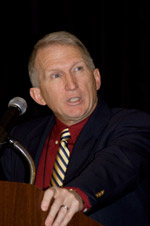Saturday General Session
Do the Old Rules Apply?
In a new era of higher prices and higher costs, do the old rules for beef production still apply? More specifically, does the economic situation alter the way beef cattle breeders should approach genetic selection? Those were the questions addressed by economist John Lawrence, during the Saturday session of the 2009 Beef Improvement Federation (BIF) Research Symposium and Annual Meeting.

John Lawrence, Iowa State University
Lawrence, who is director of Iowa State University's Iowa Beef Center (IBC), said it is no secret that managing beef production has been complicated by biofuel policy and a global recession. The U.S. is one of 40 countries implementing renewable fuel standards that have driven production of biofuels, including corn ethanol and soy biodiesel. As a result, competition for grains, as a fuel stock, has firmly linked the price of corn with that of oil.
“And now, cellulosic ethanol is the Holy Grail that everybody is chasing,” Lawrence stated, noting the U.S. goal of producing 15 billion gallons of cellulosic ethanol annually by 2022. “That, too, will create competition for many millions of acres to produce cellulose feedstocks that would otherwise produce feed for cattle.
Lawrence also noted how recession-driven changes in consumer spending are currently affecting cattle prices. He called it the “worst recession since 1982” and “a really big deal,” which has dramatically dampened personal spending among consumers. The consequence for the beef industry is that fewer consumer dollars are spent on food.
“Consumers still eat, but they are trading down,” Lawrence stated, explaining how many are choosing hamburger over middle meats. Additionally, business for “better” restaurants has slowed.
Yet, despite short-term deviations, the long-term relationship between beef producers’ input and output prices hasn’t changed much. Lawrence said the cattle price and feed price ratio remains about the same as it was in 1985.
“I would advise producers to avoid basing genetic selection on short-term deviations from the long-term relationship,” Lawrence said. “Let management address short-term issues. Genetic selection needs to have a long-term focus.”
Editor’s Note: This summary was written under contract or by staff of Angus Productions Inc. (API). To request reprint rights contact Shauna Rose Hermel, editor, at 816-383-5270. PowerPoints are posted with permission of the presenter and may not be reproduced in whole or in part without the express permission of the presenter.
The 41st BIF Research Symposium and Annual Meeting was hosted by the California Beef Cattle Improvement Association and the California Cattlemen's Association. For more information, visit www.bifconference.com or www.calcattlemen.org/bif2009.html.



